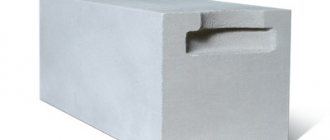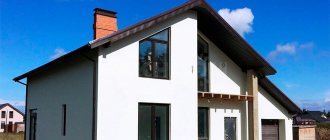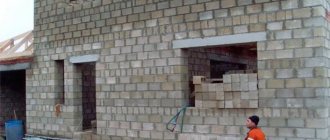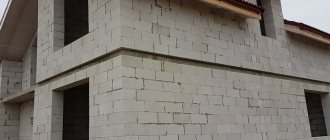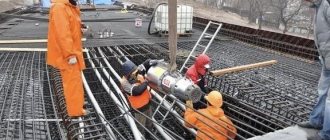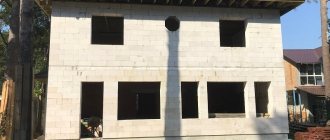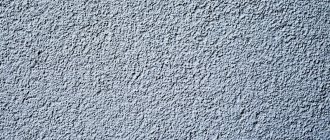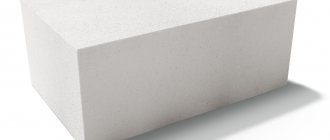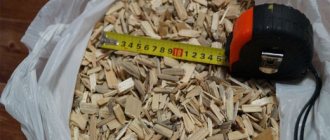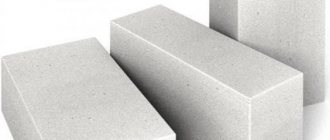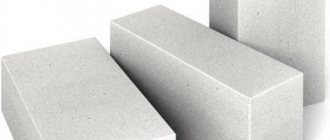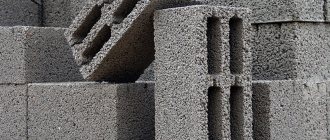What are aerated concrete blocks made of: characteristics
Aerated concrete blocks.
Aerated concrete is classified as cellular concrete, which is filled with small voids throughout its entire volume. Due to this, weight is reduced and thermal insulation performance is improved. Depending on the technology, it is divided into autoclave, non-autoclave or natural drying.
The main materials in the production of aerated concrete are cement and quartz sand; fine aluminum powder is most often used as a gas generator. Additional components can also be used - gypsum, lime, ash or slag from metallurgical production, all of which affect the characteristics.
By the way!
Since finely divided aluminum is inconvenient to use and creates dust that is hazardous to health, aluminum paste or suspension is usually added instead.
When mixing the components, aluminum begins to interact with cement or lime laitance; as a result of the reaction, calcium aluminates and hydrogen gas are formed, which causes bubbles to appear.
If you analyze the production process step by step, then first all the components are mixed, after which the required amount of water is added. As a result of the reaction, the mixture begins to swell, the composition rises like yeast dough.
After the surface has hardened, it is removed from the container and cut into blocks of the required size. They are then either steamed in an autoclave to add strength, or placed in an electric oven to dry quickly.
Minuses
Despite such a significant number of positive properties, gas silicate blocks have certain disadvantages, of which there are also many:
- Low mechanical strength . If you screw in the dowel, the product begins to break down and crumble. As a result, it is impossible to securely hold the fastener. To put it simply, you can install a picture on a wall made of a gas silicate block, but a heavy shelf is unlikely to hang there for a long time.
- Low frost resistance . The manufacturer assures that such a product is characterized by frost resistance of 5 cycles, but there is currently no confirmed data on the durability of the D300 material. You can learn about the size of the block for building a house from this article.
- Increased level of water absorption . Moisture can penetrate into the structure of the block and then have a destructive effect. The result of this process is a loss of strength
- Due to the high level of moisture absorption, liver and fungus can form on the surface of gas silicate walls. In addition, after 2 years, cracks may form in the structure of the material.
- Gas silicate blocks are characterized by a high level of shrinkage , which results in the formation of defects.
- Cement-sand plasters should not be applied to the surface of gas silicate blocks . The reason is that they will not stick firmly to the wall and will simply fall off. There is a solution - this is the use of a gypsum composition, but there is a pitfall here too. Such plaster is not capable of masking existing seams on the wall, and when cold weather sets in, cracks form. The reason is that gypsum plaster cannot withstand changes in temperature and humidity. You can find out what a block measuring 20x20x40 looks like in the description of the article.
- Due to high water absorption, plaster must be applied in two layers . During shrinkage, the resulting finish will form cracks on its surface. They do not affect the tightness, however, they violate the aesthetic beauty. Gypsum plaster adheres well to gas silicate walls and will not fall off even if there are cracks.
You can find out which block to choose for building a house from this article.
The video shows more information about the disadvantages and advantages of gas silicate blocks:
You can find out the thickness of a wall made of expanded clay concrete blocks from this article.
What aerated concrete blocks have: pros and cons
Any building material has its advantages and disadvantages that must be taken into account. As for aerated concrete, the main advantages are:
- The material is 3-5 times lighter than brick, depending on the density. Due to this, the dimensions of the elements are much larger and walls can be erected several times faster.
- Thermal conductivity is 2-3 times less in comparison with brick due to air bubbles. This provides better thermal insulation performance with a smaller masonry thickness.
- The blocks are easy to cut, drill and process. You can even use a wood tool for this, but a special hacksaw for aerated concrete is more suitable.
- The surfaces are non-flammable and can withstand exposure to open fire for several hours.
You also need to figure out why a house made of aerated concrete is bad:
House made of aerated concrete.
- Strength does not allow the construction of buildings more than 3 floors high.
- The material strongly absorbs moisture, which can negatively affect thermal insulation performance, and due to freezing of water, the surface will become covered with cracks within a couple of years. To eliminate this problem, it is necessary to finish the facade, and this is an additional cost.
- Options that are dried in electric ovens have a high shrinkage rate, so the walls may crack.
- To finish aerated concrete blocks, they must be primed, otherwise the surface strongly absorbs moisture and glue, the plaster dries unevenly, which is why it cracks.
- To give strength during installation, it is worth reinforcing every fourth row, this also adds complexity to the process; you need to use wire to prevent cracks from appearing at the seams.
Due to their hygroscopicity, aerated concrete blocks are not suitable for bathhouses, since the surface must be completely covered and treated. Many people do not know whether this type of material is harmful to health - in terms of safety, it is second only to wood, therefore it is one of the most environmentally friendly types.
Pros and cons of houses
Manufacturers of the presented building material claim that houses built on the basis of gas silicate can be compared in terms of microclimate with houses made of wood. In addition, the construction process does not take much time and effort, and you can build a home with your own efforts.
When building a bathhouse, expanded clay concrete blocks are often used. However, it is necessary to take into account all the pros and cons of a bathhouse made of expanded clay concrete blocks for further comfortable operation of the structure.
In such a house it is possible to obtain the required level of heat and air exchange, this is achieved due to the presence of pores in the gas silicate block. The house is very warm in winter, but to conserve thermal energy it is necessary to waterproof it. To preserve the ability of the house to “breathe”, it is necessary to cover it with foam plastic. When building a house, it is necessary that the seams between the blocks are minimal so that a minimum amount of thermal energy passes through them.
What is the technology for producing cinder blocks and what are the proportions, you can find out from the article.
The ease of construction will be determined by the geometry of the blocks. If it is ideal, then erecting the structure will not be difficult. When building a house from gas silicate, you need to use special glue. If you use cement mortar, you get very thick joints. This will compromise the thermal conductivity and strength of the walls. Since the blocks are very heavy, it is very difficult to complete all the activities yourself. Here you will need to take an assistant. You can find out about the pros and cons of a cinder block house in our article.
What is better, foam blocks or gas silicate blocks, can be found in this article.
When building a house, you need to take into account a number of nuances:
- It is better to build a house from such material with a maximum height of 2 floors. Otherwise, the building will not withstand heavy loads.
- When you are building a house and have already built the first floor, you must take care of the monolithic strapping belt. Then you can evenly distribute the mass of the entire second floor and roof onto the lower blocks. Every 3 rows should be reinforced with metal mesh or special sheets.
- The constructed structure requires the construction of a monolithic strip base, so it will not be possible to save money on such a structure.
- The erected walls shrink over the course of a year. This fact must be taken into account if you carry out interior decoration. Otherwise, cracks will appear in the plaster, then it is necessary to use drywall for finishing.
Gas silicate blocks dimensions and other data can be found in the description of the article.
The video shows the pros and cons of a house made of gas silicate blocks:
Indicators of strength and thermal conductivity of aerated concrete
Aerated concrete blocks.
To better understand the features of the blocks, you need to study the main characteristics. They depend on the density and method of manufacture, but several basic parameters can be distinguished:
- The strength of non-autoclaved aerated concrete blocks is 10-12 kgf/sq. cm. This is a low indicator that will not be suitable in some cases. But the autoclave version has more impressive indicators - from 28 to 40 kgf/sq.m. cm, due to steam treatment the surface is durable. Such blocks can be used almost anywhere.
- The weight ranges from 400 to 600 kg/cubic meter, which is much less than brick and concrete blocks. Therefore, carrying and loading is simplified, although the mass of one element is also significant due to its size.
- The thermal conductivity of aerated concrete is 0.12 W/mG, which is the average for modern materials. It can vary depending on the density of the material: the lower it is, the lower the thermal conductivity, since there are more air bubbles in the structure.
- Frost resistance corresponds to the F100 classification, which allows the use of aerated concrete in almost all climatic zones.
- Shrinkage rates depend on manufacturing technology. If for autoclave blocks it is only 0.2-0.5 mm, then for non-autoclave blocks it is from 2 to 5 mm, which is a lot.
- Water absorption averages 20%, which is much higher than most other materials. Therefore, during construction, increased demands are placed on surface finishing.
- Good vapor permeability allows the material to breathe, which has a positive effect on the microclimate in the house.
Depending on the density, sound permeability also differs: the lighter the blocks, the better they dampen sounds. It cannot be called an ideal option; there are many nuances that need to be taken into account.
What is a gas block
Aerated block is a universal building material.
It allows you to successfully cope with a number of construction tasks. Aerated concrete blocks are actively used in the construction of structures of various sizes and purposes, ranging from small frameless country houses to city skyscrapers. This material is also often used in the construction of shopping and entertainment complexes. The technology of construction from aerated block is not particularly complicated. Today on the Internet you can find not only step-by-step construction instructions, but also many different videos from both professionals and amateurs, clearly demonstrating the entire process from scratch.
The large dimensions and light weight of the material can significantly reduce the construction time of the building and the cost of paying for construction services. However, this does not mean that you can hire the first janitor you come across from neighboring countries instead of a construction crew. The main thing when working with any material is strict adherence to technology. If a company or team works under a contract and values its reputation, it will not make mistakes. While temporary employees are interested in the speed and simplicity of their work, but not in quality.
In addition, if you have certain skills, you can make from aerated concrete:
- columns;
- stands;
- bedside tables;
- decorative decorations that imitate stucco.
In other words, aerated concrete products can be used as a finishing and decorative material.
Why is aerated concrete bad for building a private house?
House made of aerated concrete.
To evaluate the features of building a house or cottage from this material, you need to understand what problems you will have to face. The most important aspects:
- For external and load-bearing walls, foam concrete with a density of 600 kg per cubic meter should be used. m. But its thermal insulation performance is not very high. Ideally, lay out two rows: the outer one from a more durable one, and the inner one from a loose one, then the house will be warm, but this will greatly increase the costs and labor costs of construction.
- A block 37.5 cm thick is enough for reliable thermal insulation in the middle zone. But in fact, it turns out that the walls on the outside need to be additionally insulated with foam plastic or mineral wool, which means extra money and a considerable amount of work.
- Even if the technology is followed to the smallest detail, after a few years cracks appear on approximately 20% of the blocks due to deformation occurring due to shrinkage of the foundation. The problem can be solved by pouring a monolithic foundation, but its price is several times higher than with a standard strip foundation.
- The surface must be plastered, even if insulation is not required. If left for several years, damage will occur due to freezing of moisture in the outer pores.
- Without a good primer, the surface strongly absorbs moisture. Conventional plasters do not adhere well to aerated concrete; you need to use special ones, which are more expensive.
By the way!
To hang a boiler, water heater or other heavy equipment you need to use special fasteners
If you calculate the correct wall thickness or initially rely on façade insulation, you can compensate for the shortcomings. It is also worthwhile, no later than 1-2 years, when the initial shrinkage has passed, to cover the surface with a reinforcing mesh and plaster it to hide small cracks.
Reviews
Anatoly, Ryazan .
We built a dacha several years ago. At first I was surprised at how cheap gas silicate was, I thought that I would have to spend a lot of money on insulation due to the strong porosity of the material. Good thing I was wrong. We insulated the house, but not much. Gas silicate retains heat well and in winter our temperature does not drop too low, since the house warms up in a couple of hours, even after a long absence of people in it.
Oksana, Yalta . The team of builders built our house in a couple of months. 4-5 people worked. I really liked the speed of work, after finishing we moved in immediately and I feel comfortable in the house. The husband said that there were problems with the exterior finishing: due to the smooth surface of the gas silicate, a large amount of painting mesh was used for the plaster.
Anna, Moscow . I didn't like this material because of its characteristics. Yes, it is smooth, yes, it is light, but these advantages in no way justify its low strength. I read a lot on this topic and learned from friends, I even visited houses built from this material - I didn’t like it. Therefore, brick was chosen to build his house.
Vladimir, Novorossiysk . My friends and I built a garage out of gas silicate. Excellent material, everything happens quickly and smoothly. Instead of a solution, we used ready-made glue in bags - simply diluted with water and mixed with a drill. I did not insulate the garage, since the temperature is rarely below zero.
More reviews can be found here and here.
